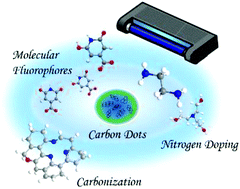Carbonization conditions influence the emission characteristics and the stability against photobleaching of nitrogen doped carbon dots†
Abstract
Carbon Dots (CDs), fabricated by hydrothermal bottom-up synthesis, are complex materials, whose optical properties are influenced by multiple factors. The presence of domains of conjugated sp2 carbon, which are formed upon carbonization of precursors at high temperature; nitrogen doping; and as recently shown, the presence of molecular fluorophores, are contributing to the emission of such CDs. We conducted a series of syntheses, each designed with specific precursors and reaction conditions that reveal the contribution of the above-mentioned factors. Specifically, we enforced carbonization by using graphene oxide as a precursor material; favored the formation of molecular fluorophores by conducting the synthesis at lower temperature and ambient pressure; and employed two different nitrogen precursors, namely ethylenediamine and triethanolamine. We compared and analyzed the distinct optical properties of the resulting products; furthermore, to address the relationship of CDs and molecular fluorophores, we examined photobleaching characteristics of these materials, under exposure to UV irradiation. From the analysis of the emission lifetimes, we revealed the quenching of the molecular fluorophores, whereas species with a higher degree of carbonization offer protection through incorporation into a carbon matrix. Based on a detailed comparison of different carbon dot species, our study provides novel physical insights into the origin of the luminescence properties of carbon dot derived nanomaterials.



 Please wait while we load your content...
Please wait while we load your content...